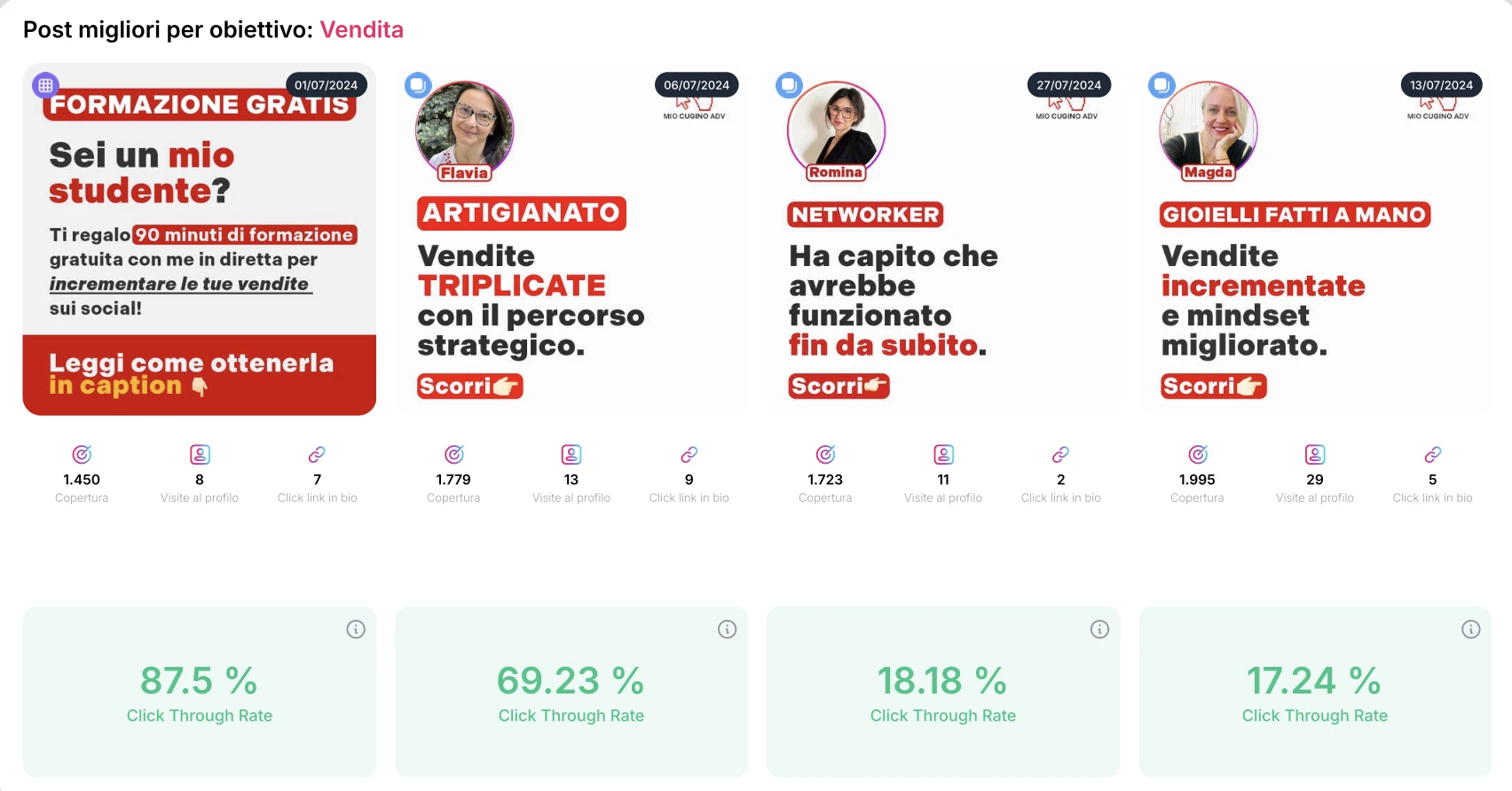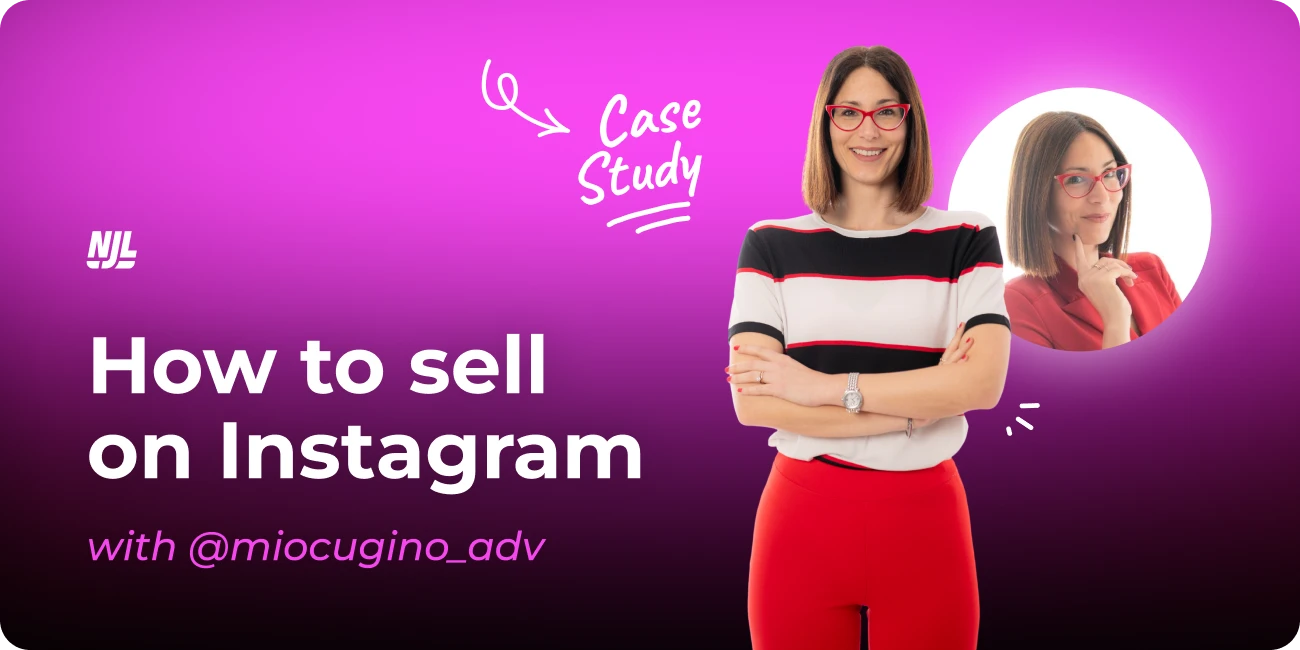You might be trying to strengthen your brand, build meaningful connections with your audience, or turn your followers into customers. However, despite your efforts, the results may not be what you expected. You’re not alone! In this article, we’ll explore how to sell on Instagram using practical strategies that can help you improve your performance and achieve real results, turning the platform’s potential into a true growth engine for your business.
What you’ll learn in this case study:
- How to improve content quality to boost sales
- Effective engagement strategies
- The importance of data analysis applied to sales
Who is Luna Mascitti?
You might have heard of her as @miocugino_adv: Luna, with years of experience in neuromarketing and storytelling, has successfully turned her Instagram profile into a real business tool. In this article, we’ll look at how, through a targeted strategy, she was able to overcome the common challenges many face when trying to convert followers into customers.
Luna has built an active and engaged community. She managed to turn her followers into a solid customer base, proving that with the right strategies, Instagram can be a valuable asset for the success of a personal profile.
The challenge: how to sell on Instagram
One of the most common problems Luna faced with her community was the difficulty of converting followers into customers. Despite having a large number of followers, many people find it hard to generate sales for their products. As Luna explains, “Many people believe that having a lot of followers is enough to sell, but without real engagement, those numbers are just vanity metrics.”
A common mistake is focusing solely on promoting products or services, often with the help of sponsorships, without developing a complete and sustainable strategy.
To better understand how to sell on Instagram, it’s essential to look beyond the follower count. At this point, we turn to Luna, who will share her experience in overcoming these challenges and offer strategies that can make a real difference, helping us understand which metrics to monitor and how to make your approach on Instagram more effective.
First myth to debunk: my industry is saturated, that’s why I’m not selling
“I have a harder product to sell” or “There’s too much competition in my industry.”
These are statements I hear all the time. The bad news is that there’s no such thing as an unsaturated market (by 2024, most markets are saturated); the good news is that you can still start selling on Instagram, carve out your own piece of the market, and get great results!
The challenge isn’t what you sell, but how you sell it. The choice of product or service shouldn’t be based on the competition you have or think you have, but on what you enjoy learning about. Let me explain: if you don’t like what you sell, if you aren’t willing to keep learning to stay updated, and if you don’t want to look for new trends in your field, you’ll never sell.
People are looking for trustworthy professionals who can provide useful information before selling them a product or service. Today, selling based solely on the lowest price doesn’t work anymore. There are countless online channels that let us compare offerings from true experts in any field, and what we seek is exactly that: a quality product or service, not necessarily the cheapest.
Here’s a practical example: I analyzed the strategy of Not Just Analytics and wondered why, even though Instagram is giving us a hard time right now, Not Just Analytics isn’t affected by the current state of the platform. The reason is clear: the NJL team keeps themselves updated, constantly evaluates new metrics, applies fresh ideas, and integrates new features. In short, they keep learning and offer quality content, meeting their community’s needs while positioning themselves as experts. If you have a question about Instagram’s algorithm, who do you turn to? That’s exactly what the market demands right now: staying on top of things.
Second myth to dbunk: being distant from your audience makes you more professional

Having conversations with your community, even just through the comments, helps you identify the topics that matter most to them or where they face the biggest challenges. This gives you the opportunity to create tailored content that addresses the real issues your community is facing. Thanks to the “Best Posts for Community” analysis, you’ll be able to identify which content has sparked the most conversation.
Third myth to debunk: viral content = guaranteed sales
“To sell, you need to go viral.”
You don’t need to create viral videos to sell on Instagram. What’s truly important is guiding people from the starting point (point A) to the destination (point B), and clearing up any doubts they have along the way. I regularly post success stories from my students on my feed, giving them the chance to share their journey and the goals they’ve achieved together with me.
My sales strategies and content creation for sales are perfectly aligned with what the Instagram platform requires. This is only possible because of my years of experience in the field and the continuous learning I engage in.

It’s no coincidence that the content I create to sell my services is the same content that Not Just Analytics highlights as the most effective for driving sales.
Conclusions
Luna has provided us with practical tips and effective strategies to improve sales on Instagram. Through her experience, you’ve learned the importance of quality content, authentic communication with your community, and the use of analytical tools to boost performance. Achieving your goals on Instagram doesn’t rely on numbers alone but on a targeted strategy and the ability to adapt to the market’s needs.
Here’s your key takeaway: the importance of a conscious, focused approach to transforming your followers into satisfied, loyal customers. Always remember, the purpose of selling is to solve a need, not create a new one.
